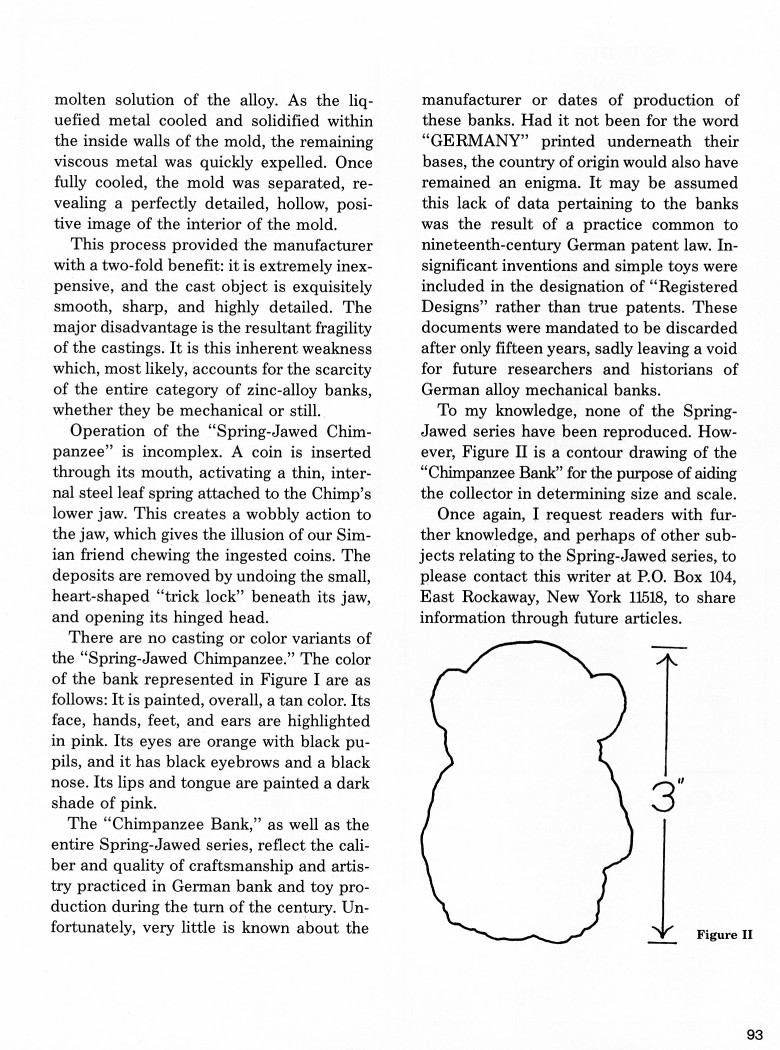|
The Spring-Jawed Chimpanzee
by Sy Schreckinger – ANTIQUE TOY WORLD Magazine – January, 1992
Members of the primate family, specifically
monkeys, were a popular subject, ofttimes utilized by nineteenth-century
manufacturers of banks and toys. Less popular, indeed, was the anthropoid
ape of Africa, known as the chimpanzee. Only two mechanical banks
represent members of this family of "Great Apes." These are the
"Chimpanzee Bank" produced by Kyser and Rex, and the "Spring-Jawed
Chimpanzee" (Figure I), subject of this article.
The "Spring-Jawed Chimpanzee" is one of seven subjects which comprise
a series of banks referred to as the Spring-Jawed Mechanicals. Other
members of this unique set include an alligator, "Bonzo" the dog, a sleepy
mule, a parrot, a grey kitten, and an English bulldog. Although the entire
spring-jawed group is scarce, the Chimpanzee is considered one of the
rarest, with possibly three or four examples known to exist in
collections.
The entire group of banks is composed of a zinc-lead alloy, commonly
referred to as "pot metal." In view of its extremely low melting point,
this material lends itself easily to a casting process called "slush
molding." This method of production entails filling a multi-sectional
hollow mold with a molten solution of the alloy. As the liquefied metal
cooled and solidified within the inside walls of the mold, the remaining
viscous metal was quickly expelled. Once fully cooled, the mold was
separated, revealing a perfectly detailed, hollow, positive image of the
interior of the mold.
This process provided the manufacturer with a two-fold benefit: it is
extremely inexpensive, and the cast object is exquisitely smooth, sharp,
and highly detailed. The major disadvantage is the resultant fragility of
the castings. It is this inherent weakness which, most likely, accounts
for the scarcity of the entire category of zinc-alloy banks, whether they
be mechanical or still.
Operation of the "Spring-Jawed Chimpanzee" is incomplex. A coin is
inserted through its mouth, activating a thin, internal steel leaf spring
attached to the Chimp's lower jaw. This creates a wobbly action to the
jaw, which gives the illusion of our Simian friend chewing the ingested
coins. The deposits are removed by undoing the small, heart-shaped "trick
lock" beneath its jaw, and opening its hinged head.
There are no casting or color variants of the "Spring-Jawed
Chimpanzee." The color of the bank represented in Figure I are as follows:
It is painted, overall, a tan color. Its face, hands, feet, and ears are
highlighted in pink. Its eyes are orange with black pupils, and it has
black eyebrows and a black nose. Its lips and tongue are painted a dark
shade of pink.
The "Chimpanzee Bank," as well as the entire Spring-Jawed series,
reflect the caliber and quality of craftsmanship and artistry practiced
in German bank and toy production during the turn of the century.
Unfortunately, very little is known about the manufacturer or dates of
production of these banks. Had it not been for the word "GERMANY" printed
underneath their bases, the country of origin would also have remained an
enigma. It may be assumed this lack of data pertaining to the banks was
the result of a practice common to nineteenth-century German patent law.
Insignificant inventions and simple toys were included in the designation
of "Registered Designs" rather than true patents. These documents were
mandated to be discarded after only fifteen years, sadly leaving a void
for future researchers and historians of German alloy mechanical banks.
To my knowledge, none of the Spring-Jawed series have been
reproduced. However, Figure II is a contour drawing of the "Chimpanzee
Bank" for the purpose of aiding the collector in determining size and
scale.
Once again, I request readers with further knowledge, and perhaps of
other subjects relating to the Spring-Jawed series, to please contact this
writer at P.O. Box 104, East Rockaway, New York 11518, to share
information through future articles.
Correction: (from
May, 1992) Refer to the article entitled "Spring-Jawed Chimpanzee,"
January
1992 issue of A.T.W. It was erroneously stated that the Chimp appears as
the subject of only two different mechanicals: the cast-iron "Chimpanzee"
bank (Kyser and Rex) and the zinc-alloy "Spring-Jawed Chimpanzee" bank (of
German manufacture). It have since been informed by a fellow mechanical
bank collector, Mr. Tom Stoddard, that he is in possession of yet a third
variety in which the chimp is featured. It also has a movable jaw and is
composed of zinc-alloy. But since it is larger and heavier and appears to
have never been painted, it bears no resemblance whatsoever to the
"Spring-Jawed Chimpanzee" bank.
|


